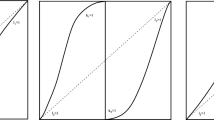Abstract
We prove a first-order limit law for functionals of two independent \(d\)-dimensional fractional Brownian motions with the same Hurst index \(H=2/d\,(d\ge 4)\), using the method of moments and extending a result by LeGall in the case of Brownian motion.
Similar content being viewed by others
References
Biane, P.: Comportement asymptotique de certaines fonctionnelles additives de plusieurs mouvements browniens. In: Séminaire de Probabilités, XXIII, Lecture Notes in Mathematics, vol. 1372, pp. 198–233. Springer, Berlin (1989)
Evans, L.C.: Partial Differential Equations, Graduate Studies in Mathematics, vol. 19. American Mathematical Society, Providence (1998)
LeGall, J.F.: Propriétés d’intersection des marches aléatoires II. Etude des cas critiques. Commun. Math. Phys. 104, 509–528 (1986)
Hu, Y., Nualart, D., Xu, F.: Central limit theorem for an additive functional of the fractional Brownian motion. Ann. Probab. 42(1), 168–203 (2014)
Nualart, D., Xu, F.: Central limit theorem for an additive functional of the fractional Brownian motion II. Electron. Commun. Probab. 18(74), 1–10 (2013)
Nualart, D., Xu, F.: Central limit theorem for functionals of two independent fractional Brownian motions. Stoch. Proc. Appl. 124(11), 3782–3806 (2014)
Kono, N.: Kallianpur-Robbins law for fractional Brownian motion. In: Watanabe, S., Fukushima, M., Prohorov, Yu.V., Shiryaev, A.N. (eds.) Probability Theory and Mathematical Statistics (Tokyo, 1995), pp. 229–236. World Scienticfic Publisher, River Edge (1996)
Nualart, D., Ortiz-Latorre, S.: Intersection local time for two independent fractional Brownian motions. J. Theor. Probab. 20, 759–767 (2007)
Wu, D., Xiao, Y.: Regularity of intersection local times of fractional Brownian motions. J. Theor. Probab. 23, 972–1001 (2010)
Xu, F. : Second order limit laws for occupation times of the fractional Brownian motion. arXiv:1310.3649
Acknowledgments
We would like to thank two anonymous referees and an associate editor for carefully reading this manuscript and making helpful remarks.
Author information
Authors and Affiliations
Corresponding author
Additional information
J. Bi is supported by National Natural Science Foundation of China (Grant No. 11301188) and Specialized Research Fund for the Doctoral Program of Higher Education of China (Grant No. 20130076120008).
F. Xu is supported by National Natural Science Foundation of China (Grant No. 11401215), Shanghai Pujiang Program (14PJ1403300) and 111 Project (B14019).
Appendix
Appendix
In this section, we prove a lemma which is important in the Proof of Theorem 1.1.
Recall that \(\fancyscript{P}_m\) is the set of all permutations of \(\{1,2,\ldots ,m\}\). For any \((\tau , \sigma )\in \fancyscript{P}_m\times \fancyscript{P}_m\), define
where
Let \(\Omega _m\) be the set of all \((\tau , \sigma )\in \fancyscript{P}_m\times \fancyscript{P}_m\) such that \(\phi _{\tau ,\sigma }\) is bijective. By Lemma 4 in [1], the number of elements in \(\Omega _m\) is
Recall the definition of \(R^{n}_{m}(a_1,a_2,b_1,b_2)\) in (3.15). The following lemma shows that
exists and does not depend on \(a_1\) and \(a_2\).
Lemma 3.4
Proof
Recall that \(Hd=2\). Then
It is easy to see that
Making the change of variables \(r_i=|y_i|\) for \(i=1,2,\ldots ,m\),
Making another change of variables \(r_i=e^{n\alpha _i}\) for \(i=1,2,\ldots ,m\), the right-hand side of the above inequality is equal to
where in the last equality we used the dominated convergence theorem and the definition of the set \(\Omega _m\).
Therefore,
On the other hand,
Since the positive constant \(K\) can be arbitrarily large,
where the last equality follows from a change of variables, the definition of Gamma function and the fact \(Hd=2\).
Combining (3.18) and (3.19) gives the desired result (3.17).\(\square \)
Rights and permissions
About this article
Cite this article
Bi, J., Xu, F. A first-order limit law for functionals of two independent fractional Brownian motions in the critical case. J Theor Probab 29, 941–957 (2016). https://doi.org/10.1007/s10959-015-0604-1
Received:
Revised:
Published:
Issue Date:
DOI: https://doi.org/10.1007/s10959-015-0604-1



